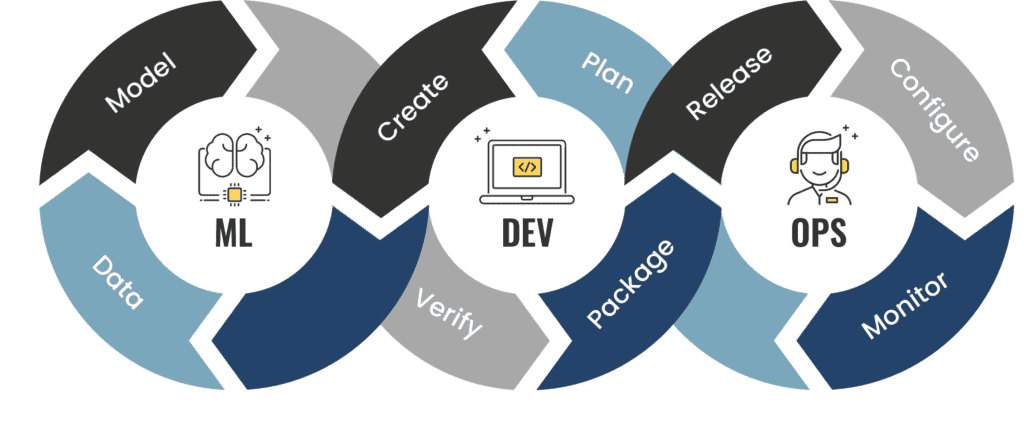
Deploy MLOps? 7 Key Requirements You Can’t Afford to Ignore
Deploy MLOps
“Give a man a fish and you will feed him for a day; teach a man to fish and you feed him for a lifetime.” You might have heard, read, and seen it in practice on a number of occasions but did you know that it is actually true when it comes to machine learning.
One of the main reasons why almost half (47%) of machine learning models fail to reach the production stage is the absence of clearly defined repeatable processes. That is why most businesses tend to struggle when it comes to integrating blockchain and machine learning into their organization. Deploy MLOps help you overcome this issue by creating a repeatable process, unifying teams across enterprises and assisting you in achieving automation project goals.
Benefits of Deploy MLOps
There are numerous benefits of deploying MLOps. Some of them are as follows:
- Uninterrupted communication and collaboration
- Create repeatable workflows which are easy to execute
- Little to no bias
- Targeted feedback
- Governance and regulatory compliance
Challenges of MLOps
Some of the biggest challenges in MLOps are as follows:
- Model reproduction and predictions
- Frequent retaining of production models
- Successful deployment and automation
- Scalability
- Monitoring and management
Why Deploy MLOPs?

According to Forrester Operationalize Machine learning study,
- 73% of enterprises thinks that machine learning adoption would give them a competitive advantage over their competitors
- 24% thinks that it can propel them to the industry leader status
- 53% believe that investing in machine learning operations will boost their profits
- 52% thinks that it will improve their customer experience
- 49% said that it helped them improve their skills and adopt data science best practices
- 41% said they have struggled to operationalize machine learning
- 21% were still in the concept stage
- 6% saying they have mature Deploy MLOps capabilities
Just like DevOps, MLOps is primarily used for monitoring development of machine learning models but it can also be used to prevent your automation projects from missing the mark or stagnating. They share many things such as continuous integration of source control, unit testing, integration testing and continuous delivery.
There are few differences as well. Whether it is team skills, team members, development process, testing, deployment, or production, you will notice a huge difference between the two. Machine learning project teams consist of researchers and data scientists and focus on data analysis and model development. Testing in Deploy MLOPs is much more comprehensive as compared to DevOps and even deployment is not as straightforward as software deployment but can help you in reducing bugs during the software development.
In this article, you will learn about seven key requirements you need to fulfill to deploy machine learning operations successfully.
1. Resource Provisioning is Critical to Success
Developing a machine learning model from scratch is not easy as it demands resources throughout the development lifecycle. The requirements tend to vary from “more” to “less” as we move from the first phase of the development cycle which is concept to the last phase which is production/implementation. The key to success is to provision infrastructure resources throughout the lifecycle
2. Model Format Compatibility
Most large-scale enterprises tend to work with multiple programming languages simultaneously and the same goes true for machine learning model development. That is why it is important for machine learning models to be compatible with multiple formats. In addition to this, it should align with the way the model has been developed while ensuring compatibility with all popular formats.
3. Overcoming Software Dependencies
If you are choosing open source tools to develop machine learning models, you are more likely to face software dependencies. If you want your machine learning model to stay relevant for a long time, you should take advantage of version control as it helps your machine learning model to continue functioning after the initial development.
4. Keep Machine Learning Models on Track
No one can deny the fact that machine learning models are not perfect. Even companies like Netflix who rely heavily on machine learning and artificial intelligence also end up offering an irrelevant recommendation. Since machine learning is trained using historical data, they are probabilistic. This means that as the environment changes, so does the data which is used to train those machine learning models. Even then, you constantly must keep an eye on them when they are in production, so they do not end up making wrong decisions.
5. Flexible Deployment Options
There are three areas where you can deploy machine learning models.
- On premise
- Cloud
- Edge
Make sure the machine learning solution you are choosing for deployment does not follow a rigid deployment pattern. The key to success is to ensure flexibility into production by offering multiple deployment options. When you are deploying a machine learning model in production, it has to go through A/B testing or online experiments before the machine learning model is ready to serve prediction requests.
6. Governance
Irrespective of what your goal and objectives are for developing a machine learning model, it is important to develop an in-depth understanding of these goals so you can ensure governance, which will facilitate machine learning model explanation and auditing. This is especially important especially when the machine learning model is being used for sensitive purposes. Good governance not only helps you win the trust of regulators but also the trust of customers and other stakeholders.
7. Retrain, Retrain, Retrain
One of the biggest downsides of machine learning models is that once the new data becomes available, it can put the machine learning model off track by bringing changes. That is why it is important to retain the machine learning models using the original data pipeline, new algorithms, and code.
Conclusion
Manage resources efficiently so that your machine learning model continues to get resources it needs throughout its development lifecycle. Avoid dependencies and compatibility issues. By fulfilling all these requirements businesses can not only find an easier route to deployment while minimizing the risk of machine learning model failure. If you want to deploy machine learning in your business operations, which process would you follow?
How do you implement machine learning operations in your organization? Let us know in the comments section below.



![05 Ways to Fix [Pii_email_bbc3ff95d349b30c2503] Error Code? 7 [Pii_email_bbc3ff95d349b30c2503] error](/media/2022/01/Pii_email_bbc3ff95d349b30c2503-error-390x220.png)
